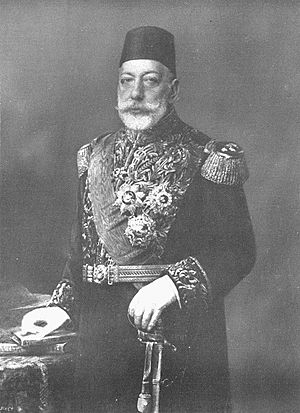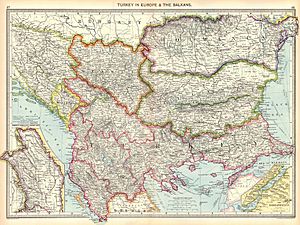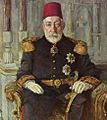Mehmed V facts for kids
Quick facts for kids Mehmed V |
|||||
|---|---|---|---|---|---|
| Ottoman Caliph Amir al-Mu'minin Custodian of the Two Holy Mosques Khan |
|||||

Photograph by Carl Pietzner, June 1915
|
|||||
| Sultan of the Ottoman Empire (Padishah) | |||||
| Reign | 27 April 1909 – 3 July 1918 | ||||
| Sword girding | 10 May 1909 | ||||
| Predecessor | Abdul Hamid II | ||||
| Successor | Mehmed VI | ||||
| Grand Viziers |
See list
Ahmet Tevfik Pasha
Hüseyin Hilmi Pasha Ibrahim Hakki Pasha Mehmed Said Pasha Ahmed Muhtar Pasha Mehmed Kâmil Pasha Mahmud Shevket Pasha Said Halim Pasha Mehmed Talat Pasha |
||||
| Born | 2 November 1844 Old Çırağan Palace, Constantinople, Ottoman Empire (present day Istanbul, Turkey) |
||||
| Died | 3 July 1918 (aged 73) Yıldız Palace, Istanbul, Ottoman Empire |
||||
| Burial | Tomb of Sultan Mehmed V Reşad, Eyüp, Istanbul | ||||
| Consorts |
|
||||
| Issue |
|
||||
|
|||||
| Dynasty | Ottoman | ||||
| Father | Abdulmejid I | ||||
| Mother | Gülcemal Kadın (Biological mother) Servetseza Kadın (Adoptive mother) |
||||
| Religion | Sunni Islam | ||||
| Tughra |  |
||||
Mehmed V Reşâd (Ottoman Turkish: محمد خامس, romanized: Meḥmed-i ḫâmis; Turkish: V. Mehmed or Mehmed Reşad; 2 November 1844 – 3 July 1918) was the 35th and second-to-last Sultan of the Ottoman Empire. He ruled from 1909 to 1918. Mehmed V was the son of Sultan Abdulmejid I. He became Sultan after his half-brother Abdul Hamid II was removed from power.
His time as Sultan, which lasted nine years, saw many big changes for the Ottoman Empire. The Empire lost lands in North Africa and the Dodecanese Islands (like Rhodes) during the Italo-Turkish War. It also lost almost all its European lands west of Constantinople (now Istanbul) in the Balkan Wars. In 1914, the Ottoman Empire joined World War I, which eventually led to its end. Even though he was Sultan, Mehmed V had little real power.
Contents
Early Life and Education
Mehmed V was born on November 2, 1844, in Istanbul, at the Çırağan Palace. His father was Sultan Abdulmejid I, and his mother was Gülcemal Kadın. He had three older sisters. When his mother died in 1851, his father's senior wife, Servetseza Kadın, took care of him and his sisters. She raised them with great kindness.
Mehmed received his education at the palace. Even though some thought his education was not the best, he was very smart. He used his intelligence to learn a lot on his own. He studied Arabic and Persian and became very good at speaking Persian. He also took piano lessons from an Italian teacher and learned calligraphy from a famous Ottoman artist.
Time as Sultan
Mehmed V became Sultan on April 27, 1909. This happened after an event called the 31 March Incident. However, he was mostly a symbolic leader. He did not have much political power. This was because a group called the Committee of Union and Progress (CUP) had gained a lot of control. In 1913, the CUP took even more power, and a group of three leaders, known as the Three Pashas, began to rule. Mehmed V was 64 years old when he became Sultan, making him the oldest person to take the Ottoman throne.

In 1911, Sultan Mehmed V traveled through some European cities that were part of the Empire. He visited Thessaloniki, Bitola, Florina, Skopje, and Pristina. He even attended prayers at the Tomb of Sultan Murad. This trip was filmed and photographed. It was the last time an Ottoman Sultan visited these European areas before the Balkan Wars began.
During his rule, the Ottoman Empire lost many territories. It lost all its remaining lands in North Africa (like Tripolitania) and the Dodecanese islands to Italy in the Italo-Turkish War. Then, in the First Balkan War, it lost almost all its European lands. Only a small area west of Constantinople remained. The Ottomans did gain back a small part of land, including Edirne, in the Second Balkan War. But this was little comfort for the huge losses.
The sudden loss of these lands, which had been Ottoman for centuries, was a huge shock. It made many people angry at the government. This led to the 1913 Ottoman coup d'etat. It also meant the end of a movement called Ottomanism. This movement had tried to give equal rights to all citizens, no matter their background, to unite the Empire. With the loss of many different groups in Europe and North Africa, this idea faded. Instead, Turkish nationalism became stronger.
Even though Mehmed V preferred to avoid more wars, his most important political act was to declare a holy war against the Allied Powers on November 14, 1914. This happened after the Ottoman government decided to join World War I on the side of the Central Powers. It is said that Mehmed V did not like the idea of siding with Germany. However, he could not stop it because the Sultan's power had become very weak.
This was the last time a Caliph officially declared a holy war. The Caliphate was later ended in 1924. Because of this declaration, Britain took over Cyprus. Egypt also declared its independence and became a British protectorate. These areas had been under Ottoman rule, even if only in name. The declaration did not have a big effect on the war. Some Arabs even joined the British forces against the Ottomans in the Arab Revolt of 1916.
Mehmed V welcomed Kaiser Wilhelm II of Germany, his ally in World War I, to Constantinople on October 15, 1917. Mehmed V was also given high military ranks by Germany and Austria-Hungary during the war.
Death
Mehmed V died at Yıldız Palace on July 3, 1918. He was 73 years old. He passed away just four months before World War I ended. This means he did not live to see the final end of the Ottoman Empire. He spent most of his life in palaces in Istanbul. His tomb is in the Eyüp district of modern Istanbul.
Family Life
Mehmed V had a small family. He was also the only Sultan who did not take new wives after becoming Sultan.
His Wives
Mehmed V had five wives:
- Kamures Kadın (1855–1921). She was his first wife and had one son.
- Dürriaden Kadın (1860–1909). She was his second wife and had one son.
- Mihrengiz Kadın (1869–1938). She became his second wife after Dürriaden's death. She had one son.
- Nazperver Kadın (1870–1929). She became his third wife after Dürriaden's death. She had one daughter.
- Dilfirib Kadın (1890–1952). She became his fourth wife after Dürriaden's death. She had no children with Mehmed.
His Children
Mehmed V had three sons and one daughter:
- Şehzade Mehmed Ziyaeddin (1873–1938) - His son with Kamures Kadın. He had many children of his own.
- Şehzade Mahmud Necmeddin (1878–1913) - His son with Dürriaden Kadın. He was born with a curved spine and never married or had children.
- Şehzade Ömer Hilmi (1886–1935) - His son with Mihrengiz Kadın. He had a son and a daughter.
- Refia Sultan (1888–1888) - His daughter with Nazperver Kadın. She died as a newborn.
Images for kids
-
Mehmed V arrives in Selânik (Thessaloniki), Ottoman Empire, 1909.
-
Wilhelm II, Mehmed V, Franz Joseph: The three emperors of the Central Powers in World War I.
-
Sultan Mehmed V hosting Kaiser Wilhelm II in Constantinople during World War I.
-
Mehmed V and Enver Pasha hosting Wilhelm II in Constantinople during World War I.
-
Mehmed V and Enver Pasha hosting Wilhelm II in Constantinople during World War I.
-
The türbe of Mehmed V is located near the Eyüp Sultan Mosque in Eyüp, Istanbul.
See also
 In Spanish: Mehmed V para niños
In Spanish: Mehmed V para niños
- The Ottomans: Europe's Muslim Emperors

















